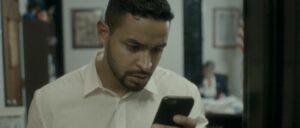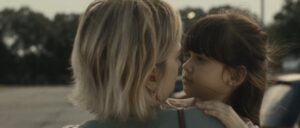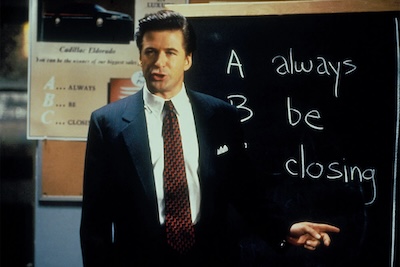The immigration process comes center stage in Sam and David Cutler-Kreutz’s thrilling and frutratingly real Live Action Short Film contender, A Lien. A young couple come face-to-face with an unstoppable enemy, and the most heartbreaking thing is that they did everything correctly before their scheduled appointment. By separating its characters in a bureaucratic setting, the directing duo mounts the tension in a stressful crescendo while never letting us forget what truly matters.
**We have linked A Lien below. Please consider watching this film before scrolling up to enjoy the interview.**
Remember when the Republican National Convention was held last summer, and images flooded social media and the news of white people holding up signs that boldly demanced, Mass Deportation Now! The signs were colored in all-American red, white, and blue, and I couldn’t help but think of that image as I watched the Cutler-Kreutzes film. A Lien might feel even darker as we enter Trump Presidency 2.0.
“It certainly has been fascinating to see the life cycle of this piece and the flow of it,” David says. “There were similar conversations happening when we were writing the film, which was during the first Trump administration. It was very topical to us. We released it in what felt like a calmer place, but now it’s going to become timely again, unfortuantely.”
“I think of that scene where Sophia is screaming at the ICE officers at the end, and there is a raw rage there,” Sam says. “Victoria [Ratermanis] does such an incredible job in that moment, and it’s a representation of unadulterated anger at a system that feels so fucking broken. And we just keep cycling back into this. It’s hard to know how it feels. On some level, it’s also depressing that people can identify with the situation where these characters find themselves.”
 Sophia and her husband, Oscar, are running late to a green card interview that could determine whether Oscar can stay in the country. Their daughter, Nina, accompanies Oscar while Sophia waits in the waiting room–it feels like any other official appointment. Suddenly, ICE officers begin to round up individuals and take them away. Sophia texts Oscar repeatedly, but he cannot answer.
Sophia and her husband, Oscar, are running late to a green card interview that could determine whether Oscar can stay in the country. Their daughter, Nina, accompanies Oscar while Sophia waits in the waiting room–it feels like any other official appointment. Suddenly, ICE officers begin to round up individuals and take them away. Sophia texts Oscar repeatedly, but he cannot answer.
“As we were writing some of the scenes around them on the phone with each other, we were talking about this kind of space of knowing someone you love needs help, but you can’t reach them,” David says. “You can’t physically get to them. We were talking a lot about George Floyd and about seeing some of the videos from that, and all of a sudden your world is through your phone. From a larger place, we wanted to talk about how the system is broken or how the system screws people, but how do we engage with that?”
“We shot it all the way through both ways,” Sam says. “We spent a lot of time with our amazing editor Caitlin [Carr], and we had full cell phone camera coverage of that middle section. We spent a lot of time trying to figure out that blend of the beginning of the movie. If you watch it back closely, it almost starts entirely from Oscar’s perspective, but as we go over the course of the scene, we just lose that perspective until that final shot is the phone on the floor pointed at the ceiling. Getting that mix right was really important to kind of dissociate in that way.”
Rather than let the tension build and then drop away, the directors start with a hurried pace from the very beginning. We can all relate to that breathless feeling of being late to a very important meeting, so they wise yank us into that frustration from the very first frame. What A Lien does so well is how it hands off that tension, as if the alarming feeling itself mutates and has an arc of its own. By knocking us off-kilter from the beginning in a seemingly innocent way, we are then rattled even more when real-life horrors take hold.
“I think part of what makes the film work, in some ways from a tension perspective, is the relatability of going to a bureaucratic scenario, whether it’s the DMV or the USCIS or TSA,” Sam says. “So many of us have been in a place like this before, and it always feels like the stakes are weirdly high even though they aren’t. When you’re in a space like that, you feel that anything can happen, and the doors open for you as a director to really move the audience around and bring tension in various way. People are already a little bit off balance.”
 “Somethng that Sam and I try to think about so much in that tension or in general is how do we really try to isolate the feeling of what folks are going through,” David says. “How do we make you, the viewer who hasn’t been part of this, get sucked into their shoes as quickly as possible to share their perspective? We were worried that we were putting you into the tension too early, and then we realized that we wanted that. Our foal is to make you not an observer here but to actually put you their exact situation so you feel what it feel like.”
“Somethng that Sam and I try to think about so much in that tension or in general is how do we really try to isolate the feeling of what folks are going through,” David says. “How do we make you, the viewer who hasn’t been part of this, get sucked into their shoes as quickly as possible to share their perspective? We were worried that we were putting you into the tension too early, and then we realized that we wanted that. Our foal is to make you not an observer here but to actually put you their exact situation so you feel what it feel like.”
“The butterflies in your stomach before you walk in the door,” Sam adds. “The film is a documents movie, in a way. It’s not a horror film. How do we film this kind of thriller in a horrific way. How do we keep you on edge as it gets worse and worse?”
Through the distress and exaspertion, though, is the point of view of Sophia and Oscar’s daughter, Nina. When they are en route to the meeting, she asks if she can have her hair braided, and Sophia obliges as the events of the day quiet down. It’s a moment of beautiful clarity to end on. After the yelling clears, the ones who are met with the most confusion or who might have the most questions are those who are inexperienced with how the world works.
“It was something we talked a lot about,” Sam admits. “We talked back and forth about whose perspective should the story be coming from. We looked at it from every character, but we kept coming back to Nina. When we think about a story like this, the impacts are so much about the kids and families. It’s about the actions of parents, and I think that it felt like we should be landing on the small things like braiding her hair. You do this whole immigration process, and people do it so they can be together. It’s about connection and family.”









